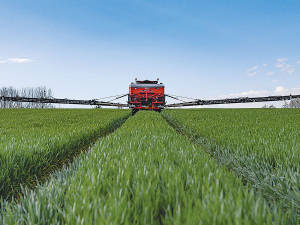Disc mower range gets upgrade
Kuhn has announced an expansion of its range of disc mowers, distributed by Norwood in New Zealand, with the addition of two new vertically folding rear mounted models, the GMD 3515 and GMD 4015.
 The spreader makes it possible to precisely deliver the right dose of fertiliser in the right place.
The spreader makes it possible to precisely deliver the right dose of fertiliser in the right place.
The new AERO 32.1 mounted, pneumatic fertiliser spreader offers working widths of 24, 27, 28, or 30 metres, to complete KUHN’s range of pneumatic fertiliser spreaders.
Fitted with a boom equipped with 24 diffusers (20 for the 24m version) that are divided into four sections, the AERO 32.1 fertiliser spreader makes it possible to precisely deliver the right dose of fertiliser in the right place.
Each section is fed by a switchable, hydraulically driven metering unit that can be adjusted individually, making it possible to modulate up to four fertiliser application rates or to shut-off individual boom sections in a single pass.
The AERO 32.1 also incorporates two weighing cells that measure the quantity of fertiliser remaining in the hopper and, if necessary, the operator can adjust the application rate by altering the speed of the metering units without a calibration test.
Fine, light, or compound fertilisers, such as urea and bulk type mixtures are typically difficult to distribute over larger spreading widths with centrifugal spreaders, but the AERO 32.1 offers precise application, right up to paddock boundaries, delivering significant savings.
With cultivation windows appearing to get shorter each season, the AERO 32.1 boom style system makes it possible to apply fertiliser in any weather conditions, even on the windiest days.
The ballistic qualities of individual fertilisers or seeds no longer matter and operators do not need to keep checking spreading tables. Similarly, the optional fine metering roller can spread a variety of material, including slug pellets, micro-granules, or even small seeds for broadcasting cover crops.
Hydraulically controlled booms fold at the rear of the hopper and well within the dimensions needed for transport.
The machine and booms can be managed via the CCI 800 or 1200 terminal or any other ISOBUS terminal already available. The use of a CCI A3 joystick is an optional extra.
Following the release to Northern European markets in 2024, availability in New Zealand, although yet to be confirmed, is expected to be in the latter part of 2025.
Grace Su, a recent optometry graduate from the University of Auckland, is moving to Tauranga to start work in a practice where she worked while participating in the university's Rural Health Interprofessional Programme (RHIP).
Two farmers and two farming companies were recently convicted and fined a total of $108,000 for environmental offending.
According to Ravensdown's most recent Market Outlook report, a combination of geopolitical movements and volatile market responses are impacting the global fertiliser landscape.
Environment Canterbury, alongside industry partners and a group of farmers, is encouraging farmers to consider composting as an environmentally friendly alternative to offal pits.
A New Zealand dairy industry leader believes the free trade deal announced with India delivers wins for the sector.
The Coalition Government will need the support of at least one opposition party to ratify the free trade deal with India.
President Donald Trump’s decision to impose tariffs on imports into the US is doing good things for global trade, according…
Seen a giant cheese roll rolling along Southland’s roads?